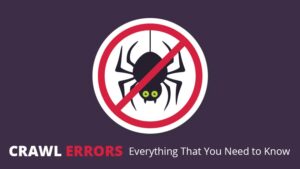Crawl errors can significantly impact how search engines index and rank a website. They prevent search engine bots from accessing crucial pages, hindering the overall search visibility of your site. Identifying and resolving these issues is essential for maintaining a healthy website and improving your SEO performance. This guide will walk you through understanding crawl errors, how to identify them, and the best practices for resolving them to enhance your site’s indexing.
What Are Crawl Errors?
Crawl errors occur when search engine bots (such as Googlebot) attempt to access a webpage but encounter an obstacle preventing them from fully crawling the page. These errors can be caused by broken links, incorrect redirects, or other technical issues. If not addressed, crawl errors can reduce your site’s search engine visibility, affecting rankings and the user experience.
Types of Crawl Errors
There are two main types of crawl errors: Site errors and URL errors. Understanding the differences helps in effectively addressing the problem.
Site Errors
Site errors occur when the entire website or a significant portion of it cannot be crawled. These errors often result from issues at the server level or network problems that prevent the site from loading.
Common Site Errors:
- Server issues: Site unavailable due to server downtime.
- DNS errors: Problems resolving domain names.
- 403 Forbidden: Search engine bots are denied access to your website.
URL Errors
URL errors, on the other hand, occur when specific pages on your site cannot be crawled. These errors are often caused by incorrect configurations or broken links.
Common URL Errors:
- 404 Not Found: Page doesn’t exist or has been deleted.
- 301 Redirect issues: Incorrect redirections.
- Soft 404: Pages that return a “Not Found” message but appear to be live.
| Type of Crawl Error | Description | Impact on Indexing |
| Server issues | Site unavailable due to server downtime | Entire site is inaccessible |
| DNS errors | Issues with domain name resolution | Site is not accessible by search engines |
| 403 Forbidden | Bots are denied access | Affects all pages on the site |
| 404 Not Found | Page does not exist | Affects only the specific page |
| 301 Redirect Issues | Improper or broken redirects | Affects page ranking and indexing |
| Soft 404 | Live page returns a “Not Found” message | Page may not be indexed |

How to Identify Crawl Errors
Search engine tools, such as Google Search Console (GSC), provide valuable insights into crawl errors. GSC’s “Coverage” report details errors that prevent proper crawling and indexing.
Steps to Identify Crawl Errors:
- Google Search Console: Check the “Coverage” report in Google Search Console to see error types like 404, server errors, and other issues.
- Crawl Tools: Use site crawlers such as Screaming Frog or SEMrush to identify crawl issues.
- Server Logs: Examine your server logs to identify specific requests that resulted in errors.
Google Search Console Crawl Error Report
| Error Type | Description | How to Identify |
| 404 Not Found | Page not found or deleted | Coverage → Excluded → Not Found |
| Server Errors | Server failure when attempting to crawl a page | Coverage → Errors → Server Errors |
| Redirect Issues | Incorrect or broken redirects | Coverage → Errors → Redirect Errors |
| Soft 404 | Pages that give 404 responses with live pages | Coverage → Excluded → Soft 404 |
Resolving Crawl Errors
Once you’ve identified crawl errors, the next step is to resolve them. The resolution will depend on the error type and its underlying cause.
Resolving Server Issues
If your website is down, it’s essential to ensure that your hosting provider resolves the issue promptly. Here’s how to address server errors:
- Check server status: Use hosting tools to verify if there are server outages.
- Update DNS records: Ensure that DNS records are correctly configured.
- Review site performance: Check for resource overloads (e.g., excessive traffic) that may impact server availability.
Resolving 404 Not Found Errors
404 errors indicate that the page requested is missing or deleted. To resolve 404 errors:
- Check URL for typos: Ensure that URLs are spelled correctly.
- Implement 301 redirects: Redirect old URLs to new ones if content has moved or been updated.
- Restore deleted pages: If pages are mistakenly deleted, restore them to their original location.
Fixing Redirect Issues
Redirect issues occur when pages are incorrectly redirected to other pages, causing indexing problems. Here’s how to fix them:
- Check redirect chains: Avoid multiple redirects leading to dead ends.
- Use permanent redirects (301): Ensure that you use 301 redirects for permanently moved pages instead of temporary ones (302).
- Eliminate soft redirects: Ensure that all redirects are legitimate and functional.
Handling Soft 404 Errors
Soft 404 errors occur when a live page displays a “Not Found” message but is still accessible. To resolve this:
- Verify page content: Ensure that the page provides useful content rather than a generic “404” message.
- Remove unnecessary pages: Delete or noindex pages that provide no value or are outdated.
Things to Consider Before Making a Decision
When deciding how to fix crawl errors, it’s important to consider the following factors:
- The scope of the issue: Is the issue isolated to a few pages or affecting the entire site?
- Website goals: Does the error impact high-priority pages or the overall SEO strategy?
- Cost of fixing: Some fixes (e.g., server issues) may require more investment, while others (e.g., 404 fixes) can be resolved quickly.
Bonus Tips for Resolving Crawl Errors
- Regular monitoring: Make crawl error checks a routine part of your website maintenance.
- Automate redirects: Use automated tools to manage redirects and avoid future errors.
- Improve site speed: A fast website improves crawlability, reducing the chances of server errors.

Make the Right Decision
Addressing crawl errors promptly is essential for optimizing your site’s SEO. Use the tools available to identify issues, understand the root causes, and apply the appropriate fixes. Regular maintenance will ensure that search engines can access and index your content properly, improving your site’s visibility and performance in search rankings.
Common Questions
What is a crawl error?
A crawl error occurs when search engine bots cannot access or index a webpage due to issues like broken links, server downtime, or redirect problems.
How do I fix a 404 error?
You can fix a 404 error by checking the URL for mistakes, restoring deleted pages, or using a 301 redirect to redirect users to a new page.
How do I check for crawl errors?
Use tools like Google Search Console, Screaming Frog, or SEMrush to identify crawl errors.
What’s the difference between a 301 and a 302 redirect?
A 301 redirect is permanent and informs search engines to transfer ranking signals to the new page, while a 302 redirect is temporary and does not pass ranking signals.
How often should I check for crawl errors?
Regularly monitor crawl errors at least once a month or after significant site updates to ensure your site is being indexed properly.